Last updated: July 6, 2021
Article
Timber-Framed Steeples - Masts and Telescoping
HISTORIC AMERICAN TIMBER-FRAMED STEEPLES
III. Masts and Telescoping
This article is third in a series to discuss the form, function and joinery of selected historic American timber-framed steeples. The series was developed from original research under a grant from the National Park Service and the National Center for Preservation Technology and Training. Its contents are solely the responsibility of the authors and do not represent the official position of the NPS or the NCPTT.
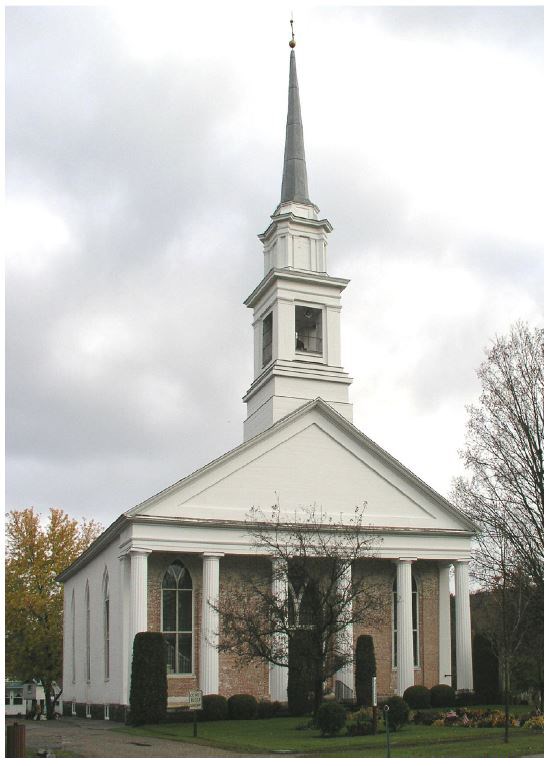
THE Castleton, Vermont, Federated Church (1832) is a brick structure in the idiosyncratic Greek Revival style of its builder, Thomas Dake. The church is 60 ft. wide with walls 28 ft. high. At the full-width portico, four fluted wood columns support a closed pediment and blank tympanum above. The steeple, which terminates 132 ft. above grade, rises from the portico and the front of the church, emerging from the roof first as a square tower, surmounted by a large square belfry. A lantern atop the belfry takes the apparent form of an irregular octagon because of the bold expression of pilasters at the corners. Above the lantern is another drum like stage closer to a regular octagon with large console-like ornament alternating with paneled faces, and atop this a tall, thin, tapering spire terminating in a gold-leafed ball and vane with directional arrow (Fig. 1).
The steeple is finished in white-painted wood except for the spire and the various skirting roofs of each stage, all now covered by lead-coated copper. Originally even the spire was finished in wood, 3-in. to 5-in. tongued and grooved beaded pine and spruce boards applied horizontally. The mitered end joints of this old wooden covering did not have corner beads at the spire arises but were covered with small overlapping bibs of zinc. This material was still in place under a layer of deteriorating tinned steel when the spire was restored by the author in 1988.
The front steeple posts bear upon the portico plate and the rear posts on a large transverse sleeper. The latter is supported by four lengthwise sleepers that bear via short posts on the front wall plate and then farther back rest on the steeply cambered lower chords of the first and second interior trusses. The first of these trusses, nearest to the rear of the tower and its load, is assisted by two posts rising to its bottom chord and concealed within the walls of the pulpit apse, the half-domed semicircular recess at the front of the audience room (Fig. 2).

The substantial load of the steeple is brought to ground at several points. Timber posts 10x10x28 concealed in the fluted portico columns rise above the columns and receive the lower ends of diagonal braces concealed in the tall portico frieze. These braces rise to the portico plate, into which the two front tower posts, 11x11x40 white pine timbers, are tenoned. The two rear tower posts descend to the 10x16 transverse tower sleeper. The four sup-porting lengthwise sleepers are large and irregular baulks of timber varying from 9x10 to 11x17, two at 28 ft. long and two at 19 ft., roughly but not exactly parallel to each other. These sleepers begin over the portico plate (but don’t bear on it), then cross and bear on short posts over the front wall plate, the load going to ground through the brick walls and stone foundation. The sleepers then pass under the transverse tower sleeper on their way to bearing on the first and second interior truss chords (Fig. 3).
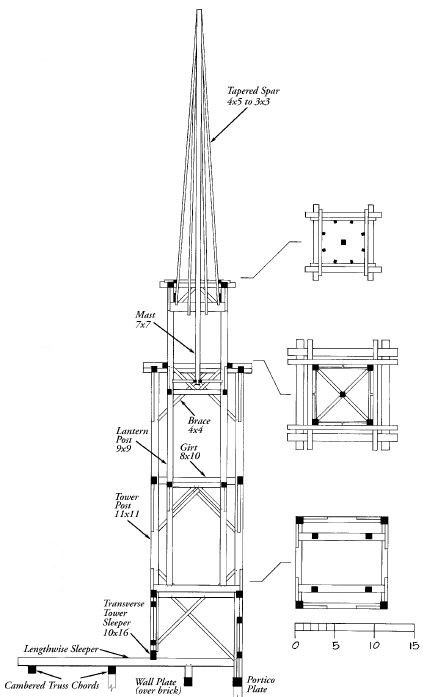
The two inner sleepers cross the first truss bottom chord about 2 ft. inboard of the points where the apse posts rise to lend support, and then continue 10 ft. to cross the second interior truss bottom chord. The two outer sleepers terminate atop the first interior truss, the easterly one crossing it about midway between a suspending princepost and a rising apse post, and the westerly angling inward to arrive right over an apse post. Substantially cambered truss lower chords rising to levels higher than the front wall plate account for the short posts between the plate and the sleepers. Farther back the sleepers sit squarely upon the cambered truss chords.
The stages of the steeple assembly are not tightly framed, but lodged, flexible and dependent upon mass and the deep tele-scoping of the stages above, a sort of vertical cantilevering, for stability. On the other hand, the steeple’s base support condition, whereby the load is brought to ground, is exceptional and substantial compared to many other churches. There is no evidence of any failure or sagging of the interior trusses that carry the rear steeple load. The several inches of rearward lean discernible in the steeple can be attributed to differential shrinkage of the cross-grain mate-rial under front and rear tower posts: a 28-in. matrix of horizontal timbers lies below the rear tower posts while the front posts sit on only 12 in. of horizontal timber. Also, some bending occurs in the 10-ft. span of the long sleepers where the transverse rear tower sleeper crosses them. So far our complex description has merely provided us with the bearing conditions of this sophisticated and well-wrought steeple and how it opportunistically acquires a variety of strong load paths down to the foundation. The stages above the tower are simpler to describe but embody their own ingenious solutions to the problems of building high with timber.
Both the tower where the steeple emerges from the roof and the belfry above it are framed by 11x11x40 white pine posts. Heavily braced girts 12 ft. up from the bottom of the posts carry two 10½ x10½ lodged sleepers. Four 9x9 posts 39 ft. long rise from mortises in these sleepers to form the frame of the irregular octagon stage above the belfry. Two levels of girts with braces below the ultimate plate level lend rigidity to this tall and slender (7 ft. 6 in. square) frame. The 9x9 posts are deeply telescoped, 28 ft. within the tower-belfry frame and merely 11 ft. projecting above it. The plate level of this inner group of posts and a ring of 2x14 planks spiked to the posts provide bearing for the eight spire rafters, partially round 4x5 spruce spars 38 ft. long. The rafters are secured to the plate by hand-forged lag screws.
Lending mass to this slender spire frame is a remarkable pendant mast, a 7x7 timber roughly 48 ft. long, suspended from spikes through the long abutments at the top of the eight rafters (Fig. 4 overleaf). The only attachments of this mast to any surrounding frame below are a set of modern, circular-sawn 4x4 timbers spiked to it near its base. These 4x4s are undoubtedly a later addition by carpenters baffled by the sophisticated framing of an earlier period. The original intent was definitely to hang the mast, allowing it to compress the boarded spire, move its center of gravity inward and down and act as a pendulum. The pendant mast telescopes as well, dropping not only below the spire rafters, but entirely through the upper octagon stages and 3 ft. below the plate of the tower and belfry frame (Fig. 3).
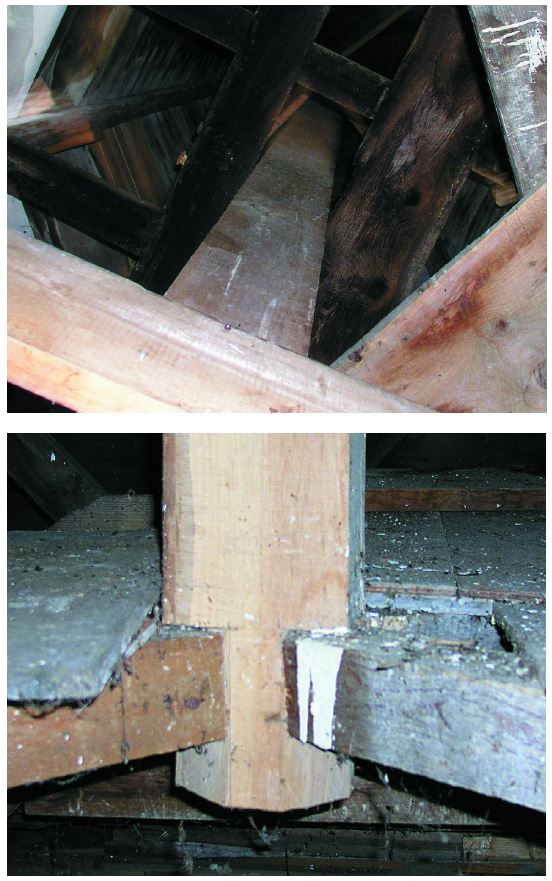
The top of the original old-growth chestnut mast served as an anchor for the vane. The 11-ft. wrought-iron vane shaft, 2 in. square at its base, penetrated 2 ft. into the top of the mast. Concealed within the mast, the bottom of the shaft was hammered into the shape of a small hook that carried the slotted upper end of a segment of ½-in. square wrought-iron lightning rod, which exited the side of the mast and eventually ran in many segments to ground. Resulting moisture condensation inside the mast and leakage at the top point of shaft entry served over time to rot even old-growth chestnut. The 7-ft. arrow of the vane was removed in the 1950s and a bucket of concrete (with chicken wire reinforcing) dumped down into the rotted top of the mast. During steeple restoration in 1988, the arrow, fortunately preserved, was reused as well as the original trident from the top. The rotted chestnut mast was replaced with a 48-ft. stick of bitternut hickory, hung from the tops of the original rafters. A downward sloping bib of leaded copper fitted to a ring groove in the vane shaft now resists water penetration, but the problem of condensation on the shaft inside the mast perhaps cannot be solved without heating the shaft.
Telescoping
Telescoping in church steeples indicates ascending stages, diminishing in cross-section, where each stage rises from some distant point within the stage below. (A contrasting method would be to build each stage directly on top of the stage below, platform style.) Without an interior survey of the tens of thousands of tall wooden towers worldwide, it’s impossible to identify the ori-gins of the telescoping technique, but suffice it to say that tele-scoping is used in a modest form in the 17th-century wooden steeples of Wren’s parochial churches in London (see plates in Clayton), in some 18th-century Polish steeples (Sadkowski 122–27) and in 18th-century chapels in remote Kenozero in northwestern Russia (Lewandoski 2002).
However, a distinction must be made between telescoping used to provide a concealed space for buttressing or rigidly bracing the stage above to the surrounding one below, and deeply lodged tele-scoping where the succeeding frames actually do not touch each other above the point of bearing. The latter operate as a sort of vertical series of self-cantilevers; there is not even joinery at the point of bearing. In such systems, the portion of any stage exposed to wind pressure may be no more than 30 to 70 percent of the stage height. The lower remainder, frequently braced and girded within itself and tenoned into its lodged bearing timbers (but not into the framework of the surrounding lower stage) is thus heavy and able to help resist any overturning moment.

In strong contrast to this form of frame engineering stands the steeple of Philadelphia’s Christ Church (1754), the tallest structure in the western hemisphere at the time of its construction (Fig. 5).
At Christ Church, the steeple’s initial brick tower is surmounted by two wooden stages stacked upon each other and bound to those below by various metal and wooden tension members, not by interpenetration of the frames themselves (Fig. 6).
The Middlebury, Vermont, Congregational Church steeple, built 1806–09 (see TF 83), presents an intermediate solution, with both deep telescoping (14 to 16 ft. of penetration) and multiple sets of partners and diagonal braces connecting each stage to the preceding stage surrounding it.
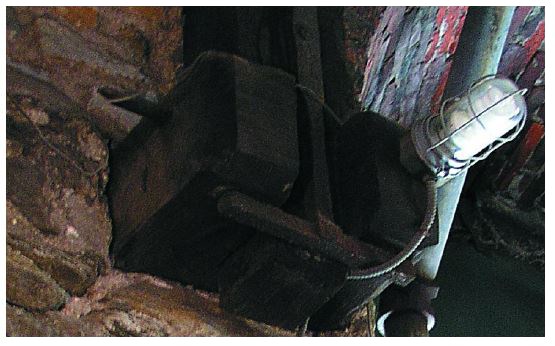
Castleton is an outstanding and successful example of deep telescoping with little or no mechanical connection between the stages other than roof boarding and flashing. Other historic examples exist in some of the great surviving wooden steeples of the 18th and early 19th centuries. In Rhode Island, the First Baptist Church of Providence (1750) has been previously studied not only for tele-scoping as an engineering solution but as an aid to assembly as well (Isham 1925 and Lewandoski 1995). Ithiel Town’s great Center Church on New Haven Green in Connecticut has four deeply tele-scoped stages. The roughly 60 ft. of spire are lodged 11 ft. down within the upper octagon stage. The octagon itself is framed by 71-ft. columns (four single sticks and four scarfed) that conceal 37 ft. of their length in the tower below and expose 34 ft. Four levels of horizontal girts with X-bracing between the levels join the octagon posts in their concealed portion. These tall columns tenon into a set of parallel 12x14 timbers not mechanically connected to each other or to the immense square tower. While modern engineers tend to choose rigid tie-down solutions, deep telescoping has been working remarkably well on many of these lightweight, very tall objects for at least 200 years.
The Pendant Mast. Here is a passage from The Travels of Marco Polo (ca. 1298), Chapter XXXI, “On the City of Samarcan and the Miraculous Column in the Church of St. John the Baptist”:
The Christian inhabitants of the place . . . proceeded to build a church and dedicated it to St. John the Baptist. It was so constructed that all the weight of the roof (being circular) should rest upon a column in the center, and beneath this, as a base, they fixed a square stone, which, with the permission of the prince, they had taken from a temple belonging to the Mahometans. But upon the death of Zagatai, his son who succeeded him showing no disposition to become a Christian, the Mussulmans had influence enough to obtain from him an order that their opponents should restore to them the stone they had appropriated; and although the latter offered to pay them a compensation in money, they refused to listen to the proposal, because they hoped that its removal would occasion the church to tumble down. . . . When the day arrived on which they were to make restitution of the stone, it came to pass through the intercession of the Saint, the pillar raised itself from its base to the height of three palms, in order to facilitate the removal of the stone, and in that situation, without any kind of support, it remains to the present day.
As we have seen, the steeple of Castleton Federated Church incorporated a pendant mast into its spire that terminated nearly 49 ft. below upon nothing. Several 1-in. boards were casually nailed to it along its length, probably as an assembly aid. At the bottom, much later, 4x4s were spiked between mast and steeple framing in a misunderstanding of the mast’s role in the stability of the spire. These were preserved in the 1988 mast replacement.
Many spires, perhaps even the majority built in the 18th and 19th centuries in the New World, have a mast at their centers, but most are rigidly footed or framed tightly to the surrounding timbers of the steeple: the Middlebury mast, for example, has joinery or tight bearing with 57 other framing members over its 53-ft. run. Castleton is designed to have nothing, but eight connections clustered at the apex.
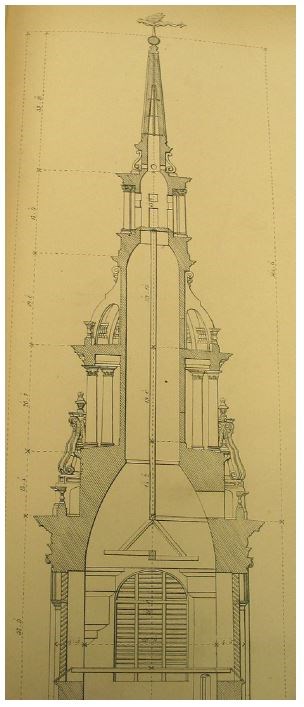
The pendant design, however, does not originate in Castleton. Setting aside apocryphal parts of the passage from Marco Polo, we infer that Nestorian Christians in Central Asia sometime between 700–1200 AD built with pendant masts to compress their domes (likely of stone). In 760 AD, Tang Dynasty framers in China constructed the three-stage tower known as the Zhenwu Pavilion, in which the interior columns supporting the penultimate roof system are suspended above the floor by cantilevered eaves (Zhang 157). While not identical to that of a pendant mast, this method is similar, to counterpose a lightweight exterior frame with some suspended weight in the interior, capable of moving slightly rather than rigidly resisting exterior forces.
Closer to home we have the pendant masts of Christopher Wren in England. In Gwilt’s Encyclopaedia we find the following (962):
Sir C. Wren, when rebuilding the upper portion of the (former) spire of Chichester Cathedral which had been forced out of the upright, placed [inside it] two intermediate stages connected with a pendant beam of timber about 80 feet in length attached to the finial stone; each stage was about 3 inches in diameter less than the spire at their levels; these restored the spire if it departed from the upright. A similar pendulum, with two stages, to act in like manner, has been introduced by Gibbs in his spire of St. Martin in the Fields, London.John Clayton includes measured drawings of the steeple framing of Wren’s surviving London churches. At least one, St. Mary le Bow (1671), contained a pendant mast with a pair of apparently free-swinging floor frames attached at its bottom (Fig. 7). The spire was unfortunately destroyed in World War II. The numerous examples of tele-scoping steeple frames illustrated by Clayton show relatively shallow penetration, and as an opportunity for concealed, rigidly connected framing and bracing, not the deep penetration and casual connections so common in eastern North America by the late 18th century.
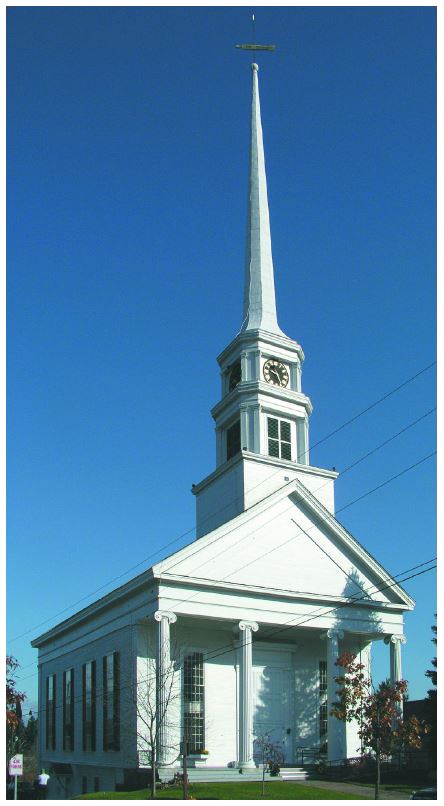
Stowe Community Church
THE steeple of the Stowe, Vermont, Community Church (1861) is remarkable for its height, 165 ft. from the ground to the top of the vane, as well as for an abundance of knowledge about the erection of its slender 90-ft. spire, described in the local newspaper at the time. The frame of the spire is further unusual for its period in being constructed entirely of spiked-together plank, including the central mast that measures 20 in. square at its base. Below the spire, the steeple is timber framed, generally in a very substantial fashion.
The Stowe church is 50 ft. wide with a wall height of 29 ft. sill to plate. The pedimented portico with undecorated tympanum is supported by four fluted columns. The tower or first stage of the steeple, 19 ft. square, crosses the portico, front wall and the first interior roof truss. A belfry stage in the form of an irregular octagon appears next, followed by a clock stage, also an irregular octagon, and finally the tall, slender spire with a vane on top, com-posed of a ball, a directional arrow and a golden arrowhead (or leaf) pointing heavenward (Fig. 8). The spire is covered with small galvanized steel panels painted white. The original covering was tin on steel, also in smallish, approximately 2x3-ft. pieces. The tower, belfry and clock stage are white-painted woodwork. Pilasters with inset paneling build out the corners of the octagon, which express the framing, clock faces or louvers fitted in between. The style is Greek Revival with an extremely tall and pointed Gothic element on top, a very popular combination at the time. The 1930 “Brief Historical Sketch” by the Stowe Community Church says of the building, “The lines undoubtedly were copied from the work of England’s famous architect, Sir Christopher Wrenn [sic],” a claim that thousands of other small-town churches can make as well.
The tower stage, 22 ft. tall, rises from 8x8 sleepers that sit atop the portico plate, the front wall plate and the first interior truss chord. These sleepers run back to within inches of the second interior truss but inexplicably don’t reach it (Fig. 11). Braces descend back from the rear tower posts to the unsupported ends of the sleepers. The only rationale I can summon for this framing, other than error in the length of the sleepers, is the builders’ intent to provide a form of spring to absorb rearward movement of the steeple, although at 6 ft. long the 4x4 braces cannot resist much load. The four tower posts, girts, and plates are all 8x8 spruce timber, with 4x4 braces mortised but unpinned, variously hewn or vertically sawn.
The belfry stage rises in telescoping fashion from short sleepers (now sistered with steel channels) that lie diagonally across the corners of the tower sleepers; the belfry framing begins only 8 in. above the tower base. The belfry is framed by the method of partners, borrowed from the nautical practice for securing a mast where it passes through deck levels. From each of the four diagonal belfry sleepers pairs of 35-ft. 8x10 columns rise (these are not the partners), separated by deeply tenoned spacer blocks and carrying tie beams that cross and through-tenon into the opposing pair of posts at two intermediate levels and the top. The half-lapped crossing of these pairs of tie beams, 8x8s at the intermediate levels and 8x10s at the top level, produces a square opening at the center into which the mast can be inserted and wedged. The paired horizontal timbers are the partners.
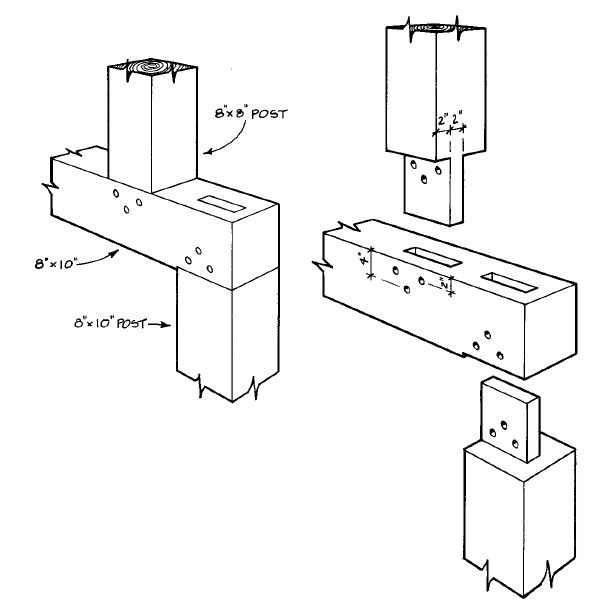
The partner posts are given architectural expression as the corner posts of the irregular octagonal belfry, the four narrow sides of the octagon bounded by the paired posts and the four wide sides occupying the spaces between sets of partners. Partner posts and tie beams in turn support another level of 10-ft. 8x8 paired posts, producing another partner ensemble to clasp the mast again at a higher point. The architectural expression of this upper partner framing is the irregular octagon of the clock stage above the belfry.
While the belfry stage is telescoped for 22 of its 35 ft., the clock stage is not telescoped at all, but rather deeply tenoned into the top level of horizontal partners of the belfry stage. The 2-in. through-tenons of the posts are 8 in. wide and 10 in. long, each affixed by three 1-in.-dia. pins to make a tension connection. The belfry partners that carry this higher stage are also through-tenoned onto the tops of the belfry partner posts, again with three pins in recognition of the significant uplift or overturning that may occur here (Fig. 9).
Out of these two levels of partners rises the built-up central mast, nearly 90 ft. tall and the attached lightly framed spire it anchors (Figs. 10–11). The rafters of the spire are paired 2x4s, many of them from a 1950s repair, while, in each of the eight spire panels, inter-mediate long flatwise 2x4s (at least one of which is original and vertically sawn) serve as nailers for the single layer of horizontal boarding lying under the metal. The spire rafters are attached repeatedly to the mast with various plank and board braces, likely installed as the carpenters built upward when the spire stood on the ground next to the church. A set of plank partners clasps the mast directly on top of the highest timber partners. The now-inaccessible nailing of some of the plank partner elements tells us that they were attached to the mast on the ground before it was lifted and inserted.
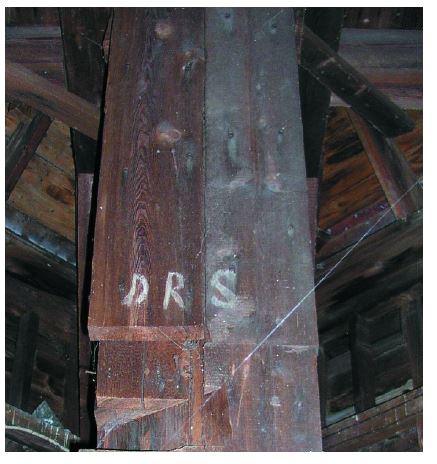
How did the mast arrive at the top of the steeple? We learn from the nearby Morrisville, Vermont, Lamoille Newsdealer of September 27, 1861, that once Mr. Edgerton of Charlotte (about 40 miles dis-tant), together with his horse and a 100-ft. ginpole acquired locally—and undoubtedly a lot of rope, pulleys and a capstan—had lifted the spire above the three in-place stages, it was lowered and affixed at several locations. First, the spire rafters and their sheathing and metal cladding, a rigid eight-sided cone, were brought to bear upon and spiked to the plate of the topmost stage. (Were this the spire’s only connection, it would now be missing.) Second, the mast, 20 in. on a side at this point, extended 11 ft. below the bearing of the rafters and was tightly clasped by two sets of partners: one at the top of the deeply telescoped clock stage and another at the top of the belfry stage. Third, a tension connection was made at the foot of the mast where a captive bolt within the mast dropped some 20 in., attaching to a 3x16 hardwood plank crossing under the partners immediately below the foot of the mast. There are two unexploited opportunities to clasp this mast between partners at lower levels in the belfry frame. Apparently the framers thought it unnecessary to extend the mast down another 23 ft., and they were right.
In our study of steeple framing we have now seen the spire mast designed to operate in three different ways. In the Middlebury Congregational Church in 1806 it was used as the central axis of several deeply telescoped stages and joined rigidly to them at 53 locations. At Castleton in 1832 the mast was originally pendant, attached only at the top and used as a pendulum. At Stowe in 1861 the mast was clasped rigidly only at its base, dependent upon the massive surrounding partner framing to resist uplift and over-turning moments from above. These three churches were built within a 55-year period, 30 to 100 miles apart, in a culturally homogenous region. They testify to the diversity and wealth of inventiveness in traditional framing. ––Jan Lewandoski
Jan Lewandoski (jlrt@sover.net) operates Restoration and Traditional Building in Stannard, Vermont. This article is third in a series on his-toric American timber-framed steeples. Ken Rower, Jack Sobon and Ed Levin assisted in steeple research.
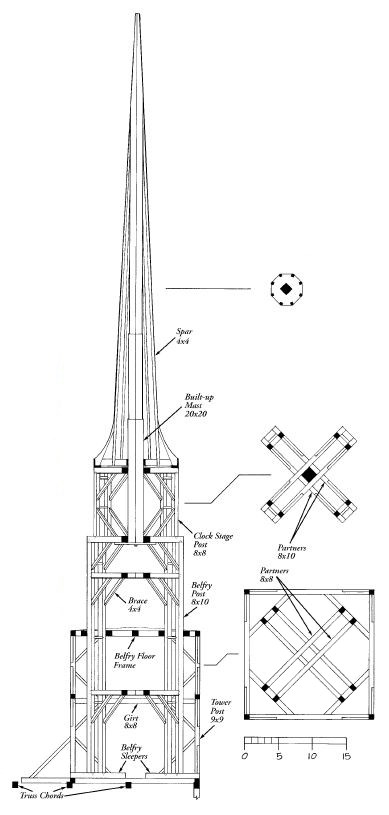
BIBLIOGRAPHY
Clayton, J. Works of Christopher Wren. London, 1848–9.
Congdon, H. W. Dake of Castleton. Montpelier, Vt., 1949.
Gottlieb, R. et al. History of the Community Church. Stowe, Vt., 1981.
Gwilt, J. The Encyclopaedia of Architecture. London, 1867.
Isham, N. The Meetinghouse of the First Baptist Church in Providence. Providence, 1925.
Lewandoski, J. “The Erection of Church Steeples.” TF 36, 1995.
—–. “Kenozero and Timber Buildings in Northwest Russia.” TF 66, 2002.
Polo, M. The Travels of Marco Polo. Beijing, 1989.
Sadkowski, T. Drewniana Architektura Sakralna Na Pomorzu Gdanskim w XVIII-XX Wieku. Gdansk, 1997.
Zhang, Y. History and Development of Ancient Chinese Architecture. Beijing, 1986.
